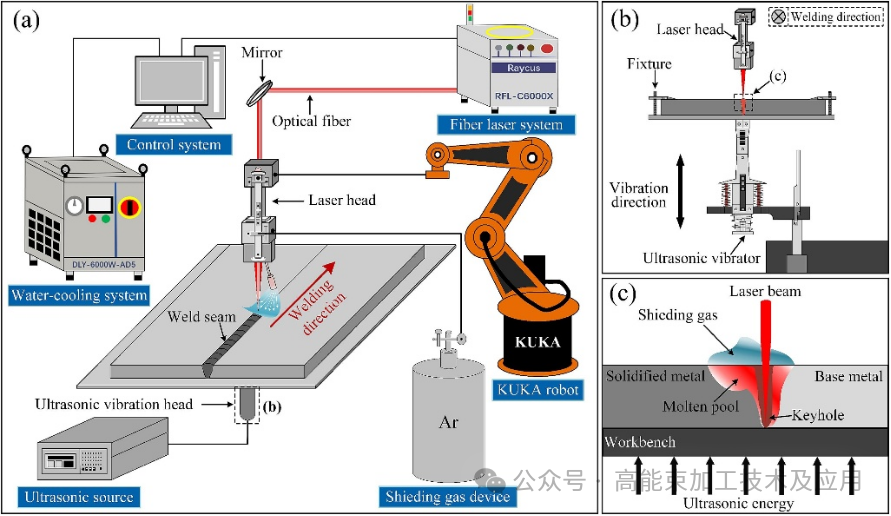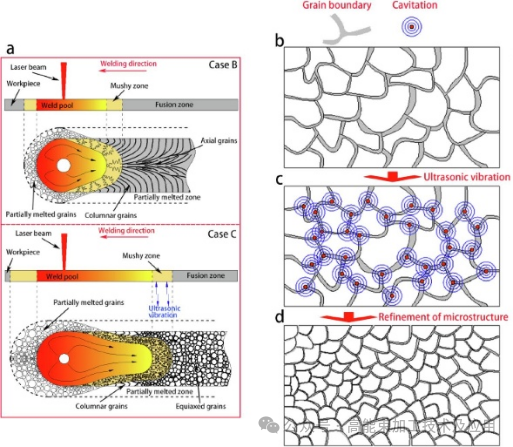
01 Introduction
Laser welding technology has become a core process in modern precision manufacturing due to its advantages of concentrated energy, high precision, and minimal deformation. However, its characteristics of rapid melting and solidification pose challenges when processing highly reflective materials (such as copper and aluminum), including unstable energy absorption and a high tendency to produce pores and hot cracks. In particular, when welding dissimilar materials, the formation of brittle intermetallic compounds severely weakens joint performance. These limitations restrict its broader application in high-end fields such as power batteries and aerospace.
In recent years, ultrasonic vibration technology has been increasingly introduced in material processing to enhance traditional processes and achieve unprecedented manufacturing flexibility. Beyond its established applications in cleaning, sonochemistry, metal treatment, and atomization, ultrasound is becoming a key auxiliary enhancement method in advanced manufacturing platforms, including precision machining, advanced welding, laser processing, and additive manufacturing. Consequently, to overcome some of the inherent limitations of laser welding, an innovative solution—Ultrasonic Vibration-Assisted Laser Welding (UVA-LW)—has emerged (Fig. 1). This technology creatively introduces high-frequency ultrasonic vibration into the laser welding process, aiming to utilize ultrasound’s unique effects of acoustic streaming, cavitation, and stress interaction to directly regulate molten pool flow, gas behavior, and solidification at the physical level. Through this “acousto-optic synergy,” UVA-LW can effectively stir the molten pool, promote degassing, refine grains, and suppress the formation of brittle phases, significantly improving weld quality and performance while opening a promising new path for solving long-standing challenges in conventional laser welding.

Figure 1. Schematic diagram: (a) UVA-LW experimental setup; (b) Molten pool morphology during UVA-LW; (c) Characteristics of molten pool flow during UVA-LW[1].
02 Core Principle: Synergistic Effects of Sound and Light
The essence of ultrasonic vibration-assisted laser welding lies in the comprehensive optimization enabled by the acoustic energy field—from the physical behavior of the liquid molten pool, to microstructural evolution during solidification, and finally to residual stress control in the cooled solid state.
First, in the liquid stage, high-frequency ultrasound generates strong acoustic streaming and cavitation effects in the molten pool, creating “microscopic stirring” and “high-efficiency purification.” Acoustic streaming induces directional macroscopic flow similar to an internal stirrer, vigorously mixing the molten pool (Fig. 2) and forcing uniform temperature and composition distribution. This is particularly important for dissimilar-metal welding, as it breaks up the continuous brittle intermetallic layer at the interface, dispersing it into fine particles and markedly improving joint toughness.
Meanwhile, cavitation produces countless microbubbles that collapse instantaneously, releasing intense shock waves and high-speed microjets. On one hand, these forces remove oxide films on the molten surface and improve wetting; on the other hand, they dislodge dissolved hydrogen, nitrogen, and other gases, forcing them to escape upward, fundamentally suppressing porosity formation.
Next, during the solidification stage, the periodic high-pressure shock waves induced by cavitation act as a powerful tool for regulating microstructures. As columnar dendrites grow, ultrasonic shock waves fragment them. The broken dendrite arms are carried throughout the molten pool by acoustic streaming, becoming numerous new heterogeneous nucleation sites—a mechanism of “fragmentation-induced nucleation.” This fundamentally changes the solidification mode, suppresses coarse columnar grains, and ultimately produces fine equiaxed grains that greatly enhance weld strength, ductility, and resistance to hot cracking.
Finally, in the solid state after cooling, ultrasound continues to facilitate stress relief through acoustic softening. Acoustic softening temporarily enhances ductility in the high-temperature zone of the weld and heat-affected region, promoting microplastic deformation and easing shrinkage-induced stress. Meanwhile, continuous high-frequency vibration provides additional energy for atomic and dislocation movement, promoting redistribution and relaxation of internal stresses. Thus, from liquid purification and homogenization to solidification refinement and stress release, ultrasonic vibration works synergistically with the laser heat source to systematically solve key limitations of traditional laser welding.

Figure 2. Effect of ultrasound on fluid flow in the molten pool: (a) Without ultrasound; (b) With ultrasound[1].
03 Application Advantages: Significant Quality and Performance Improvement
The core acousto-optic synergy ultimately translates into substantial improvements in weld quality and joint performance. Compared with conventional laser welding, ultrasonic vibration-assisted laser welding offers three primary advantages in solving long-standing industry challenges:
3.1 Reduction of Welding Defects (Porosity and Cracking)
Porosity and cracking are two critical threats to weld reliability, and ultrasound significantly suppresses both.
(1) Porosity suppression: In conventional laser welding (especially deep penetration welding), keyhole instability and metal vapor entrapment easily cause porosity. With ultrasound, cavitation and acoustic streaming provide strong degassing forces. Cavitation collapse breaks or coalesces micro gas bubbles, driving them upward, while acoustic streaming promotes escape pathways and buoyancy. As a result, weld density increases significantly, and porosity can be reduced by an order of magnitude or more—crucial for sealing reliability and fatigue life.
(2) Crack resistance: Welding cracks include hot cracks and cold cracks. For hot cracks, ultrasound fragments coarse columnar grains, promotes equiaxed grains, and reduces low-melting eutectic segregation, thereby improving high-temperature crack resistance. For cold cracks, acoustic softening and stress release reduce residual stress accumulation, suppressing delayed hydrogen cracking or stress-induced fracture, with particularly strong effects on high-strength and hardenable steels.
3.2 Improvement of Dissimilar-Material Joint Properties
The biggest challenge in dissimilar metal welding lies in the formation of thick, brittle intermetallic compounds (IMCs) due to large differences in physical properties (e.g., melting point, thermal conductivity). Ultrasound offers a unique solution:
(1) IMC suppression and refinement: Acoustic streaming acts as mixing to disrupt newly formed IMC layers, preventing continuous growth. Broken IMC fragments are dispersed into the molten pool and distributed as fine particles, embedded within a tough matrix rather than forming a brittle interface. This dramatically improves plasticity and toughness. For instance, in Al/steel and Al/Cu welding, IMC thickness can be controlled below several micrometers or even lower.
3.3 Optimization of Weld Morphology and Mechanical Properties
Beyond eliminating defects, ultrasound enhances overall weld formation quality.
(1) Improved weld morphology: Ultrasound reduces apparent viscosity and increases fluidity of molten metal, enabling better spreading and filling, smoother weld surfaces, and reduced undercut and incomplete fusion. Improved wetting results in a smoother transition between the weld and base metal, reducing stress concentration.
(2) Comprehensive mechanical enhancement: With porosity elimination, microcrack suppression, and grain refinement (Fig. 3), weld strength and ductility improve simultaneously—breaking the classical trade-off between strength and plasticity. Fine equiaxed grains create tortuous crack paths, significantly enhancing fracture toughness and fatigue resistance.

Figure 3. (a) Shape and macroscopic morphology of the molten pool with and without ultrasound; (b) Microstructure without ultrasound vibration; (c) Microstructure refinement process; (d) Refined microstructure formed under ultrasound vibration[2].
04 Conclusion
As an innovative composite energy-field processing method, UVA-LW not only supplements and optimizes traditional laser welding but fundamentally solves its long-standing core challenges. By precisely coupling high-frequency acoustic energy into the laser molten pool, the technology achieves deep “acousto-optic synergy,” enabling full-chain performance enhancement—from liquid-state purification and solidification control to solid-state stress release.
With increasingly stringent requirements for joint quality in applications such as new energy vehicles (especially copper–aluminum connections in power batteries), aerospace (lightweight high-strength alloys and dissimilar structures), and high-end precision manufacturing, ultrasonic vibration-assisted laser welding shows tremendous application potential. Future research directions may focus on: (1) synergistic optimization of ultrasonic and laser parameters for “customized” welding of specific materials; (2) integrating the technology with online monitoring and intelligent control systems to achieve closed-loop real-time quality assurance; and (3) expanding applications in additive manufacturing to control residual stresses and microstructural performance.
It is foreseeable that ultrasonic vibration-assisted laser welding will not only serve as a “problem solver” but also become a “performance enhancer,” providing a feasible pathway toward higher performance and more reliable material joining.
References
[1] Guo, J., Wang, J., Cheng, L., Duan, Y., & Zhan, X. (2024). Unravelling the mechanism of columnar-to-equiaxed transition and grain refinement in ultrasonic vibration assisted laser welding of Ti6Al4V titanium alloy. Ultrasonics, 141, 107342.
[2] Liu, Z., Jin, X., Zhang, J., Hao, Z., & Li, J. (2022). Microstructure evolution and mechanical properties of SUS301L stainless steel sheet welded joint in ultrasonic vibration assisted laser welding. Optics & Laser Technology, 153, 108193.
**--Cite the article published by 高能束加工技术 on November 17, 2025, in the WeChat public account "High-Energy Beam Processing Technology and Applications."




















